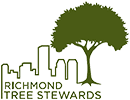The purchase of labels & tags for trees was made possible by the Alliance for the Chesapeake Bay through a grant from Altria.
The crunch and smell of autumn leaves underfoot, the subdued light of a winter sun through leafless limbs, the hope of fresh spring buds bursting forth from their winter sleep, the lazy shade of a warm summer day … whatever the season, whatever the weather, it’s always the right time to enjoy a leisurely stroll among the trees in Richmond’s parks. Come follow the marked trails and see how many trees you can identify without first looking at their tags (no cheating!). Even if you can’t tell a Southern Red Oak from a Red Maple, you are sure to enjoy the breadth and variety of trees just waiting for your visit.

1 Common name: The term, often descriptive words, is commonly used to describe a plant or animal. Difficulties can occur when there is more that one name for the same species or one name for several different species.
2 Species name: The scientific term that refers to a specific species of plant or animal. Using this term avoids the confusion that can occur when common names are used.
3 Native, Non-native or Invasive: Native species occur naturally in specific areas and fill an ecological niche there. Non-native species are those that were brought to an area by human activity, some intentionally, others not and these species typically do not support the web of life in the way that native species do. Invasive species are those non-native species which have become prolific, disrupt natural communities and threaten biological diversity.
4 QR code— Connects you to the Virginia Tech fact sheet for that species. This site has more information about the trees as well as images of leaves, flowers, and seeds that you will not be able to view on the tree in all seasons.
!!!!! Beware of poison ivy. Learn more here !!!!!
When tags were placed on these trees, poison ivy was not present. That, however, can change in a season. Birds eat the berries and and spread the seed, often near the base of a tree where they sprout and grow. If you notice poison ivy growing on one of our tagged trees, please let us know by using the contact link below.
Let us know what you think…
Did you enjoy the tree walk? Do you have questions?
Did you see something that needs attention?
